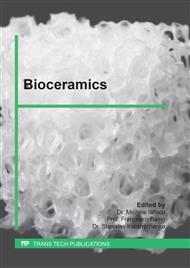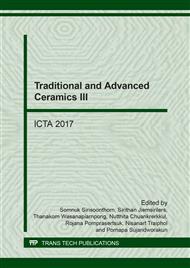[1]
D. Shi and X. Wen, Bioactive ceramics: Structure, Synthesis, and Mechanical properties. Introduction to biomaterials: pp.13-28.
Google Scholar
[2]
H. Arami, M. Mohajerani, M. Mazloumi, R. Khalifehzadeh, A. Lak and S.K. Sadrnezhaad, Rapid formation of hydroxyapatite nanostrips via microwave irradiation. Journal of Alloys and Compounds, 2009. 469: pp.391-394.
DOI: 10.1016/j.jallcom.2008.01.116
Google Scholar
[3]
R. Nazir, N. Iqbal, A.S. Khan, A. Akram, A. Asif, A.A. Chaudhry, I.U. Rehman and R. Hussain, Rapid synthesis of thermally stable hydroxyapaptite. Ceramics International, 2012. 38: pp.457-462.
DOI: 10.1016/j.ceramint.2011.07.027
Google Scholar
[4]
J. Liu, K. Li, H. Wang, M. Zhu and H. Yan, Rapid formation of hydroxyapatite nanostructures by microwave irradiation. Chemical Physics Letters, 2004. 396(4–6): pp.429-432.
DOI: 10.1016/j.cplett.2004.08.094
Google Scholar
[5]
S.J. Kalita and S. Verma, Nanocrystalline hydroxyapatite bioceramic using microwave radiation : synthesis and characterization. Materials Science and Engineering, 2010. C30: pp.295-303.
DOI: 10.1016/j.msec.2009.11.007
Google Scholar
[6]
S. Bose, S. Dasgupta, S. Tarafder and A. Bandyopadhyay, Microwave-processed nanocrystalline hydroxyapatite: Simultaneous enhancement of mechanical and biological properties. Acta Biomaterialia, 2010. 6: pp.3782-3790.
DOI: 10.1016/j.actbio.2010.03.016
Google Scholar
[7]
A. Siddharthan, S.K. Seshadri and T.S.S. Kumar, Influence of microwave power on nanosized hydroxyapatite particles. Scripta Materialia, 2006. 55(2): pp.175-178.
DOI: 10.1016/j.scriptamat.2006.03.044
Google Scholar
[8]
T. Kokubo and H. Takadama, How useful is SBF in predicting in vivo bone bioactivity, Biomaterials, 2006. 27: p.2907–2915.
DOI: 10.1016/j.biomaterials.2006.01.017
Google Scholar
[9]
Y.Z. Wang and Y. Fu, Microwave-hydrothermal synthesis and characterization of hydroxyapatite nanocrystallites. Materials Letters, 2011. 65: p.3388–3390.
DOI: 10.1016/j.matlet.2011.07.095
Google Scholar
[10]
P. Sooksaen, N.Pengsuwan, S.Karawatthanaworrakul and S.Pianpraditkul, Formation of Porous Apatite Layer during In Vitro Study of Hydroxyapatite-AW Based Glass Composites, Advances in Condensed Matter Physics, 2015: Article ID:158582, 9 pages.
DOI: 10.1155/2015/158582
Google Scholar
[11]
N. Olmo, A.I. Martin, A.J. Salinas, J. Turnay, M. A. Lizarbe, Bioactive sol–gel glasses with and without a hydroxycarbonate apatite layer as substrates for osteoblast cell adhesion and proliferation. Biomaterials, 2003. 24: p.3383–3393.
DOI: 10.1016/s0142-9612(03)00200-x
Google Scholar



